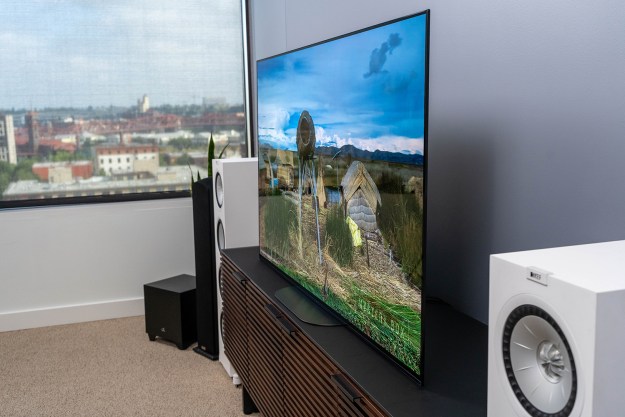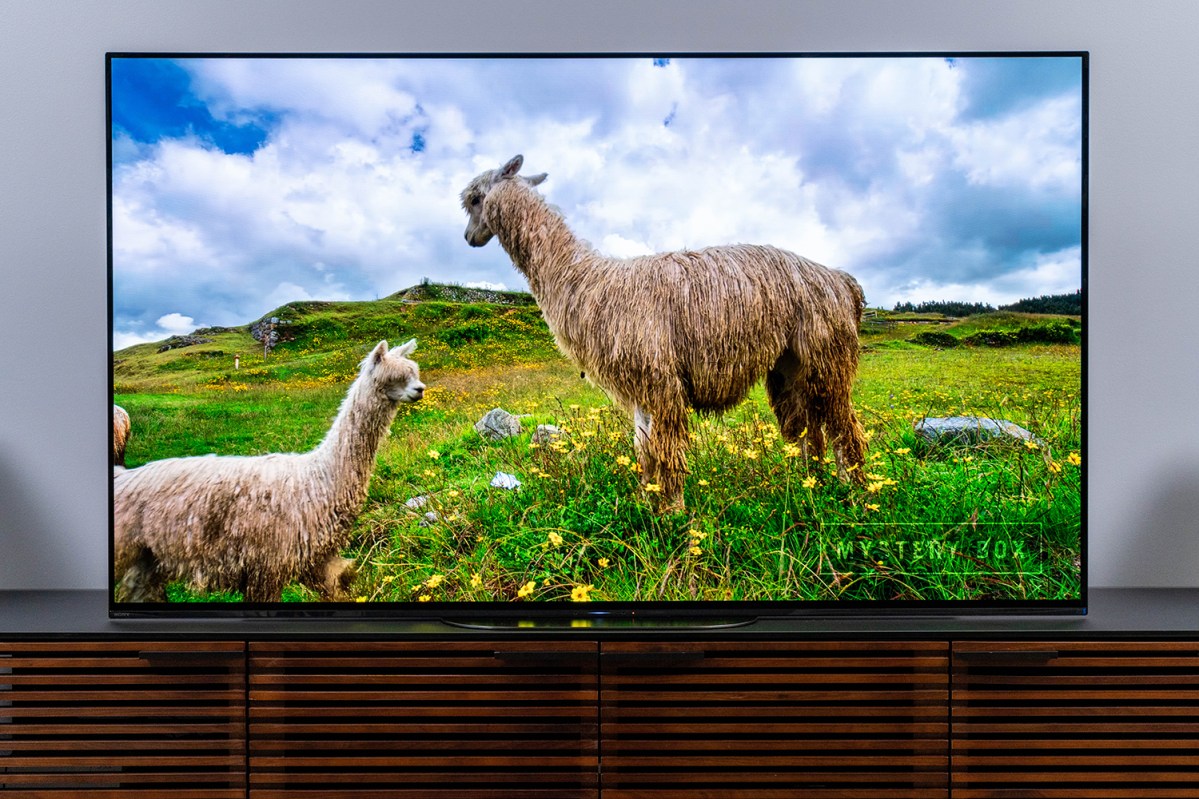
- Perfect black levels
- Outstanding color, contrast
- Superior picture processing
- Excellent HDR performance
- Impressive sound quality
- Not as bright as LG OLEDs
The Sony A9G OLED TV is the best TV you can buy in the U.S. this year. Thanks for reading!
Ah, if it were only that easy. But such a bold statement has to be qualified, so I will do my best to do so below. Certainly, the A9G has tight competition coming from LG’s own OLED TVs, Samsung’s QLEDs, and, believe it or not, some surprising competition from TCL’s Micro LED sets.
Yet when everything is weighed, the Sony A9G comes out on top for me. Here’s why.
It’s gorgeous
The Sony A9G’s design might not be entirely practical for those who intend to stand-mount it, but its design is inarguably sexy. With a slightly raked back, ultra-thin profile and a bottom edge that seems to melt into your entertainment stand, the A9G (available in 55-,65-, and 77-inch variants) is especially fetching. Ultra-trim bezels seal the deal as soon as the TV is turned on, revealing a canvas that’s almost all-picture and no edges.

The A9G also finally gets an upgraded remote control with only a slight design tweak, but a significant improvement in materials thanks to a brushed metal finish. The remote is weighty and satisfying to hold, if not a bit dated due to its excessive size and density of buttons.
It sounds great
I understand few folks buy such a premium TV for its sound quality, but the A9G is worth listening to. Thanks to Sony’s Acoustic Surface technology, the TV’s screen is the speaker, and before you dismiss it as a gimmick, allow me to point out that I think this is one of the most meaningful innovations in TV technology to come along in some time.
Using actuators behind the screen, Sony is able to get the glass panel to produce surprisingly clear, balanced sound with a strong sense of directionality. What this means is that voices and sound effects seem to come from their location on the screen. For example, if two people on opposite sides of the screen are speaking to each other, you’ll hear their voices come from opposite sides of the screen, seemingly from the character’s mouths.

If you’re thinking a glass screen might sound a little thin in the lower tones, you’d be right. On its own, the screen can’t produce much bass, so Sony incorporates little “subwoofers” to enhance the on-screen sound, rounding things out beautifully.
The fidelity is impressive enough that I endorse using one of the A9G’s more thoughtful features: Utilizing the TV as the center channel in a multi-speaker surround sound system. On the back of the TV is a set of speaker wire terminals into which one can route the center channel output from an A/V receiver. The TV will then take that signal and use the TV’s sound system to reproduce all the dialog and effects coming from the A/V receiver. Audiophiles might balk at the idea, but I’ve heard it in a voice-matched Sony surround system, and it was fantastic.
Android TV actually works
Leave it to Sony to step up and use a processing chip that can handle the demands of the Android TV platform. Where other TVs slug, struggle, and stutter through Android TV’s resource hog of a platform, the A9G’s dedicated processor makes it as smooth as … well, every other smart TV platform. With the A9G, I actually used this the built-in platform instead of plugging in a Roku streaming stick as I have prior Sony TV models.
Along with Android TV comes Chromecast capability and, soon, Google Stadia for streaming top gaming titles without the need for a console.
Best picture you can buy
The LG Z9 88-inch 8K OLED may be the most impressive TV I’ve ever reviewed, but the Sony A9G has the best picture quality you can/should buy this year. I say this realizing that the LG C9 offers highly competitive picture quality for a bit less money and a bit less design flair (for which you could step up the E9, I suppose), and yes, all OLED TV panels are made by LG right now. But in the end, Sony’s processing makes LG’s OLED panel look better than LG does.
The TVs you see from Philips and Panasonic in the UK and other non-U.S. markets are using LG OLED panels, just as Sony is. And, as we’ve seen in prior years, all these OLED TVs look very good, but they do not look the same.
The magic is in picture processing, and Sony has picture processing perfected.

It’s not so subtle a difference, either. Both Sony and LG OLED TVs benefit from professional calibration, but look excellent right out of the box, with the LG and Sony on par in color and the LG slightly ahead in white balance when in incomparable picture modes. But even if we set out-of-box color accuracy aside, one can see the aggregate difference between the two displays with the naked eye.
The Sony has less judder when displaying 24p movie content and more natural motion without any motion smoothing turned on. The A9G can clean up low-bitrate streaming content better than LG’s sets do, resulting in fewer artifacts and less color banding. In fact, some streaming content looked remarkably close to the 4K Blu-ray version of the same.
Yet, it is Sony A9G’s judicious handling of HDR content which has me choosing it over competing OLEDs. It is true that LG’s OLED TVs are designed to be much brighter than Sony’s but, in my opinion, maintaining highlight details is more important.
Sony does a great job of balancing punch in specular highlights by maintaining bright highlight detail. In side-by-side comparisons, the difference is obvious, and I call Sony the winner.

Using popular comparison titles like Peter Pan, Batman vs. Superman, and The Revenant on 4K Blu-ray, I was able to see several instances where the LG blew out bright highlight detail for the sake of higher peak brightness. Side by side, the LG looked more punchy, but the Sony always looked more balanced, and when viewed on its own, I never felt the Sony lacked punch or presence. It was always a dazzling picture.
The same can be said for the A9G’s handling of shadow detail, which is admittedly a difficult trick to pull off. By their nature, OLED pixels have a steep slope as they move from dark grey to black. As such, it is hard for OLED TVs not to “crush blacks” by going from the greyscale ladder straight to black, skipping several steps in the process and therefore losing detail in dark areas.
Somehow, Sony handles this issue better than its competitors. Once again, I felt like I got the most balanced, even picture possible.

That’s the critical, drill-down analysis, but you don’t have to be a videophile to see the A9G is an impeccable TV. Over the course of weeks of evaluation, dozens of co-workers stopped by to see what I was working on and each of them made the same comment: Wow!
And that’s just it: The Sony A9G is a “Wow” TV. It’s delightfully well-refined while simultaneously down to party. Whether watching sports, playing games, or enjoying a beautifully shot movie, the Sony A9G delivers what content creators want you to see better than any other TV you can feasibly buy right now. It should come as no surprise, then, that the Sony A9G takes the top spot in our Best TVs of 2019 list.
Our Take
Sony’s A9G is a superb example of what decades of expertise in engineering can produce. Thanks to Sony’s outstanding processing, the A9G outperforms every other 4K TV I’ve tested this year, OLED or otherwise.
Is there a better alternative?
As usual, this will depend on your needs. If you’re a gamer, I would urge you to look to an LG OLED thanks to its future-proofed, full-spec HDMI 2.1 ports, along with extremely low input lag, variable refresh rate, auto low latency mode, and future features not yet enabled — just don’t play the same game five hours a day for four months in a row or you might see some burn-in.
If you’re not interested in OLED, consider the Samsung Q90R QLED or the Sony X950G. Both are outstanding premium LED/LCD TVs. For a budget-friendly option, consider the 2019 TCL 6-Series (R625).
How long will it last?
The Sony A9G should last a long time thanks to Sony’s excellent track record of build quality. As far as future-proofing goes, I’d like to see the same full-spec HDMI 2.1 ports that LG offers on its 2019 OLED TVs, but considering there’s no practical use for
Warranty
Sony offers a one-year warranty for its A9G series TVs, provided you purchase the TV from an authorized dealer. The warranty is specific about keeping product packaging, so take a look at the fine print here.
Should you buy it?
Yes. If you have the means, buy the Sony A9G in any of its available sizes. This is an astonishingly good television.
Editors' Recommendations
- Best Samsung TV deals: Save on 4K TVs, QLED TVs, OLED TVs, 8K TVs
- Best Walmart TV deals: 43-inch 4K TV for $195 and more
- Best Buy TV deals: Save on QLED TVs, OLED TVs, and 8K TVs
- Best OLED TV deals: Save on LG C3, Samsung S90C, and more
- Samsung’s new 98-inch DU9000 4K TV is just $4,000. Can it beat TCL and Hisense?





